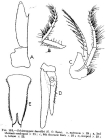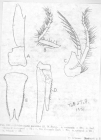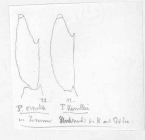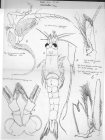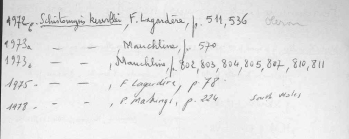
| About | | Search taxa | | Taxon tree | | Checklist | | Attributes | | Photogallery | | Stats | | Log in |
WoRMS taxon detailsSchistomysis kervillei (G.O. Sars, 1885)
120203 (urn:lsid:marinespecies.org:taxname:120203)
accepted
Species
Mysis kervillei G.O. Sars, 1885 · unaccepted (basionym)
Paramysis kervillei (G.O. Sars, 1885) · unaccepted (Synonym)
marine,
(of Mysis kervillei G.O. Sars, 1885) Sars, G. O. (1885). Description d'une espèce nouvelle de Mysis. Mysis kervillei, G.O. Sars. <em>Bulletin de la Société des Amis des Sciences naturelles de Rouen.</em> 21(3e Série): 92-98, plate V. (look up in IMIS) [details]
Depth range shallow water
Depth range shallow water [details]
Mees, J.; Meland, K.; Väinölä, R. (Eds) (2012 onwards). World List of Lophogastrida, Stygiomysida and Mysida. Schistomysis kervillei (G.O. Sars, 1885). Accessed through: World Register of Marine Species at: https://www.marinespecies.org/aphia.php?p=taxdetails&id=120203 on 2025-07-15
Date action by
Nomenclatureoriginal description
(of Mysis kervillei G.O. Sars, 1885) Sars, G. O. (1885). Description d'une espèce nouvelle de Mysis. Mysis kervillei, G.O. Sars. <em>Bulletin de la Société des Amis des Sciences naturelles de Rouen.</em> 21(3e Série): 92-98, plate V. (look up in IMIS) [details] basis of record van der Land, J.; Brattegard, T. (2001). Mysidacea. <em>In: Costello, M.J. et al. (Ed.) (2001). European register of marine species: a check-list of the marine species in Europe and a bibliography of guides to their identification. Collection Patrimoines Naturels.</em> 50: pp. 293-295. (look up in IMIS) [details] Taxonomytaxonomy source
Norman, A.M. 1892 . On British Mysidae, a family of Crustacea Schizopoda. - Ann. Mag. nat. Hist., ser. 6, 10: 143-166, 242-263, 2pls, available online at https://www.biodiversitylibrary.org/page/27658748 [details] taxonomy source Makings, P. (1977). A guide to British coastal Mysidacea. <em>Field Studies.</em> 4: 575-595. [details] Available for editors taxonomy source Makings, P. (1978). Two rare species of Schistomysis (Mysidacea) from South Wales. <em>Crustaceana.</em> 35: 223-224. [details] Available for editors taxonomy source Mauchline, J.; Murano, M. (1977). World list of the Mysidacea, Crustacea. <em>J. Tokyo Univ. Fish.</em> 64 (1): 39-88. (look up in IMIS) [details] taxonomy source Walker, A. O. (1892). Revision of the Podophthalmata and Cumacea of Liverpool Bay. <em>Proc. Liverpool Biol. Soc.</em> 6: 96-104. [details] taxonomy source Gordan, J. (1957). A bibliography of the order Mysidacea. <em>Bull. Am. Mus. Nat. Hist.</em> 112 (4): 281-393. [details] Available for editors taxonomy source Harms, J. (1993). Check list of species (algae, invertebrates and vertebrates) found in the vicinity of the island of Helgoland (North Sea, German Bight): a review of recent records. <em>Helgoländer Meeresunters.</em> 47: 1-34. [p. 25, tab. 3: Gastrosaccus spinifer, Mysis relicta, Praunus inermis, Schistomysis kervillei, Schistomysis spiritus. (look up in IMIS) [details] redescription Hoek, P. P. C. (1886). Crustacea Nederlandica. <em>Tijdschr. Nederl. Dierk. Ver., ser. 2.</em> 1: 93-105, 1 pl. [details] redescription Zimmer, C. (1932). Über einige Mysidaceen des Musée Royal d'Histoire naturelle, Brussels. <em>Bull. Mus. Roy. Hist. Nat. Belg.</em> 8 (21): 1-12. (look up in IMIS) [details] Available for editors Identification resourceidentification resource
Tattersall, W.M.; Tattersall, O.S. (1951). The British Mysidacea. <em>Ray Society, London.</em> 1-460, figs. 1-118. (look up in IMIS) [details] Available for editors Othercontext source (Schelde)
Maris, T., O. Beauchard, S. Van Damme, E. Van den Bergh, S. Wijnhoven & P. Meire. (2013). Referentiematrices en Ecotoopoppervlaktes Annex bij de Evaluatiemethodiek Schelde-estuarium Studie naar “Ecotoopoppervlaktes en intactness index”. [Reference matrices and Ecotope areas Annex to the Evaluation methodology Scheldt estuary Study on “Ecotope areas and intactness index”. <em>Monitor Taskforce Publication Series, 2013-01. NIOZ: Yerseke.</em> 35 pp. (look up in IMIS) [details]
context source (BeRMS 2020) Bio-environmental research group; Institute of Agricultural and Fisheries research (ILVO), Belgium; (2015): Macrobenthos monitoring in function of the Water Framework Directive in the period 2007-2009. [details] additional source Price, W. (2001). World list of Mysidacea. [details] additional source Müller, H. G. (1993). World catalogue and bibliography of the recent Mysidacea. 238p. [details] Available for editors additional source Mees, J.; Cattrijsse, A.; Hamerlynck, O. (1993). Distribution and abundance of shallow-water hyperbenthic mysids (Crustacea, Mysidacea) and euphausiids (Crustacea, Euphausiacea) in the Voordelta and the Westerschelde, southwest Netherlands. <em>Cahiers de Biologie Marine.</em> 34: 165-186. (look up in IMIS) [details] Available for editors additional source De Batselier Karine (1995): Hyperbenthische gemeenschappen van het Belgisch Kontinentaal plat [details] additional source Muller, Y. (2004). Faune et flore du littoral du Nord, du Pas-de-Calais et de la Belgique: inventaire. [Coastal fauna and flora of the Nord, Pas-de-Calais and Belgium: inventory]. <em>Commission Régionale de Biologie Région Nord Pas-de-Calais: France.</em> 307 pp., available online at http://www.vliz.be/imisdocs/publications/145561.pdf [details] additional source Tattersall, W.M.; Tattersall, O.S. (1951). The British Mysidacea. <em>Ray Society, London.</em> 1-460, figs. 1-118. (look up in IMIS) [details] Available for editors additional source San Vicente C. & Sorbe J-C. (1990). Biologia del Misidaceo suprabentonico Schistomysis kervillei (Sars, 1885) en la plataforma continental Aquitana (Suroeste de Francia). Bentos, 6, 245-267. [details] Available for editors additional source Mees, J.; Dewicke, A.; Hamerlynck, O. (1993). Seasonal Composition and Spatial Distribution of Hyperbenthic Communities Along Estuarine Gradients in the Westerschelde. <em>Netherlands Journal of Aquatic Ecology.</em> 27, 2-4, 359-376. (look up in IMIS) [details] Available for editors additional source Hayward, P.J. & J.S. Ryland (Eds.). (1990). The marine fauna of the British Isles and North-West Europe: 1. Introduction and protozoans to arthropods. <em>Clarendon Press: Oxford, UK.</em> 627 pp. (look up in IMIS) [details] Available for editors additional source Dewicke, A., V. Rottiers, J. Mees & M. Vincx. (2002). Evidence for an enriched hyperbenthic fauna in the Frisian front (North Sea). <em>Journal of Sea Research.</em> 47(2): 121-139. (look up in IMIS), available online at https://doi.org/10.1016/s1385-1101(02)00106-5 [details] Available for editors additional source Mauchline, J. (1972). The biology of bathypelagic organisms, especially Crustacea. Deep-Sea Research 19(11):753-780, figs. 1-11, tabs. 1-4. (xi-1972) [details] Available for editors additional source Wooldridge, T. H.; Mees, J. (2011 onwards). World List of the Mysidacea. [details] additional source Hostens, K.; Mees, J. (1999). The mysid-feeding guild of demersal fishes in the brackish zone of the Westerschelde estuary. <em>Journal of Fish Biology.</em> 55(4): 704-719. (look up in IMIS), available online at https://doi.org/10.1006/jfbi.1999.1026 [details] additional source Van Der Baan, S.M., & L.B. Holthuis. 1971. Seasonal occurence of Mysidacea in the surface of plankton of the southern North Sea near the "Texel" lightship.-- Netherlands Journal of Sea Research 5 (2): 227-239. [details] Available for editors additional source BEAUDOUIN, J. (1979). Euphausicés, mysidacés, larves de décapodes du Golfe de Gascogne (plateau continentale) en 1971 et 1972. - Rev. Trav. Inst. Pêch. marit., 43 (4): 367-389 [details] Available for editors additional source Beyst, B.; Cattrijsse, A.; Mees, J. (1999). Feeding ecology of juvenile flatfishes of the surf zone of a sandy beach. <em>Journal of Fish Biology.</em> 55: 1171-1186. [details] Available for editors additional source CUNHA, M.R. & JORBE J.C. & BERNARDES C. (1997). On the structure of the neretic suprabenthic communities from the Portugese continental margin Marine Ecology progress series 157: 119-137 [details] Available for editors additional source Hamerlynck, O.; Hostens, K. (1993). Growth, feeding, production and consumption in O-group bib (Trisopterus luscus L.) and whiting (Merlangius merlangius L.) in a shallow coastal area of the south-west Netherlands. <em>J. mar. Sci.</em> 50: 81-91. [details] Available for editors additional source HERMAN, J. (1969). Aasgarnalen - (Mysidacea) Tabellenserie van de strandwerkgemaanschap, koninklijke Nederlandse Natuurhistorische vereniging, Nederlandse jeugdbond voor natuurstudie & de Christelijke jeugdbond van Natuurvrienden; 23 [details] Available for editors additional source KÜHL, H. (1964). Die Mysiden der Elbmündung. - Abh. Verh. naturw. Ver. Hamburg, N.F. 8: 167-178 [details] Available for editors additional source Lagardère, F. (1975). Biologie du Ceteau, <i>Dicologoglossa cuneata</i> (Moreau) éthologie alimentaire. <em>Revue des Travaux de l'Institute des Pêches Maritimes.</em> 39(1): 63-103. [details] Available for editors additional source MAUCHLINE, J. (1971). Rare species of Mysidacea (Crustacea) from the west coast of Scotland. - J. mar. biol. Ass. U.K., 51: 799-808 [details] Available for editors additional source MAUCHLINE, J. (1971). Seasonal occurence of mysids (Crustacea) and evidence of social behaviour. - J. mar. biol. Ass. U.K., 51: 809-825. [biology, ecology [details] Available for editors additional source MAUCHLINE, J. (1971). The biology of Schistomysis kervillei (Crustacea, Mysidacea). - J. mar. biol. Ass. U.K., 51: 653-658 [details] Available for editors additional source MAUCHLINE, J. (1971). The fauna of the clyde sea area. Crustacea: Mysidacea, with a key to the species. In H.T. Powell (ed.), The Fauna of the Clyde Sea Area. Scott. mar. biol. Ass., Oban: 26pp [details] Available for editors additional source MAUCHLINE, J. (1973). Intermoult growth of species of Mysidacea (Crustacea). - J. mar. biol. Ass. U.K., 53: 569-572. [development [details] Available for editors additional source MEES J., FOCKEDEY N., DEWICKE A., JANSSEN C., SORBE JC (1995). ABERRANT INDIVIDUALS OF NEOMYSIS INTEGER AND OTHER MYSIDACEA: INTERSEXUALITY AND VARIABLE TELSON MORPHOLOGY NETHERLANDS JOURNAL OF AQUATIC ECOLOGY 29(2) 161-166 [details] Available for editors additional source Mees, J.; Fockedey, N.; Hamerlynck, O. (1995). Comparative study of the hyperbenthos of three European estuaries. <em>Hydrobiologia.</em> 311: 153-174. [details] Available for editors additional source Mees, J.; Hamerlynck, O. (1992). Spatial community structure of the winter hyperbenthos of the Schelde estuary, the netherlands and the adjacent coastal waters. <em>Netherlands Journal of Sea Research.</em> 29(4): 357-370. [details] Available for editors additional source Mees, J.; Jones, M. B. (1997). The hyperbenthos. <em>Oceanography and marine Biology: an annual review.</em> 35: 221-255. (look up in IMIS) [details] Available for editors additional source Méndez, N.; Romero, J.; Flos, J. (1997). Population dynamics and production of the polychaete Capitella capitata in the littoral zone of Barcelona (Spain, NW Mediterranean). <em>Journal of Experimental Marine Biology and Ecology.</em> 218(2): 263-284., available online at https://doi.org/10.1016/s0022-0981(97)00078-6 [details] Available for editors additional source Platt, H. M. (1980). The significance of free-living nematodes to the littoral ecosystem. <em>Systematics association special volume.</em> 17(b), 729-759. [details] Available for editors additional source SORBE, J.C. (1991). Biologia del Misidàceo suprabentónico Schistomysis ornata (Sars, 1864) en la plataforma continental aquitana. - Actas V Simp. Ibér. Estud. Bentos Mar., 1: 273-298. [biology [details] Available for editors additional source WILLEMS, W.; DEPREZ, T. (1999). Vergelijking van het dieet van Pomatoschistus lozanoi en P. Minutus van het strand van Oostduinkerke Maandwerk Labo Mariene Biologie [details] Available for editors  Present Present  Present in aphia/obis/gbif/idigbio Present in aphia/obis/gbif/idigbio  Inaccurate Inaccurate  Introduced: alien Introduced: alien  Containing type locality Containing type locality
From editor or global species database
Depth range shallow water [details]Habitat on sandy bottom [details] Remark an euryhaline and eurythermic species [details]
To Barcode of Life
To Biodiversity Heritage Library (7 publications) (from synonym Mysis kervillei G.O. Sars, 1885) To European Nucleotide Archive, ENA (Schistomysis kervillei) To GenBank (6 nucleotides; 5 proteins) To PESI (from synonym Mysis kervillei G.O. Sars, 1885) To PESI (from synonym Paramysis kervillei (G.O. Sars, 1885)) To PESI To USNM Invertebrate Zoology Arthropoda Collection (6 records) To ITIS |
